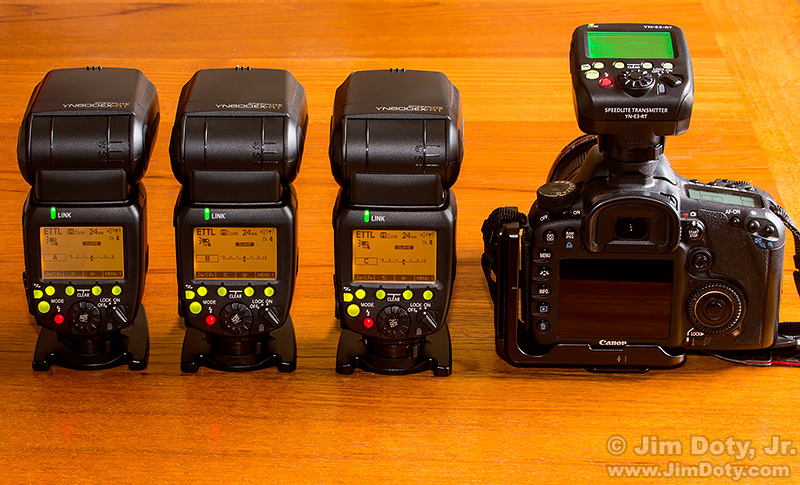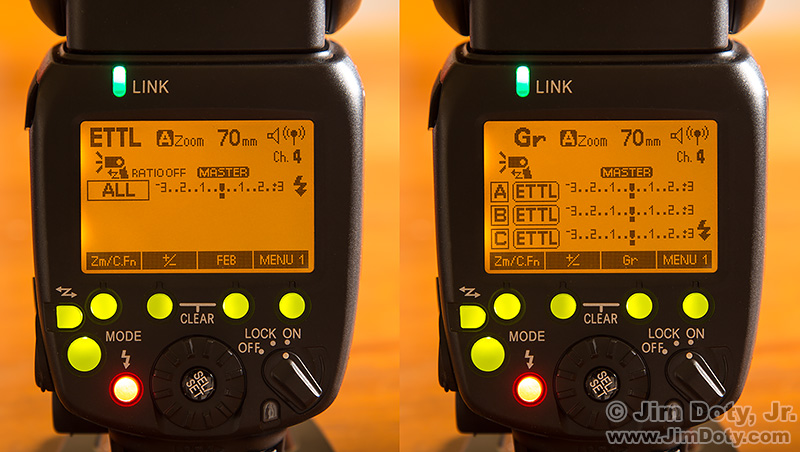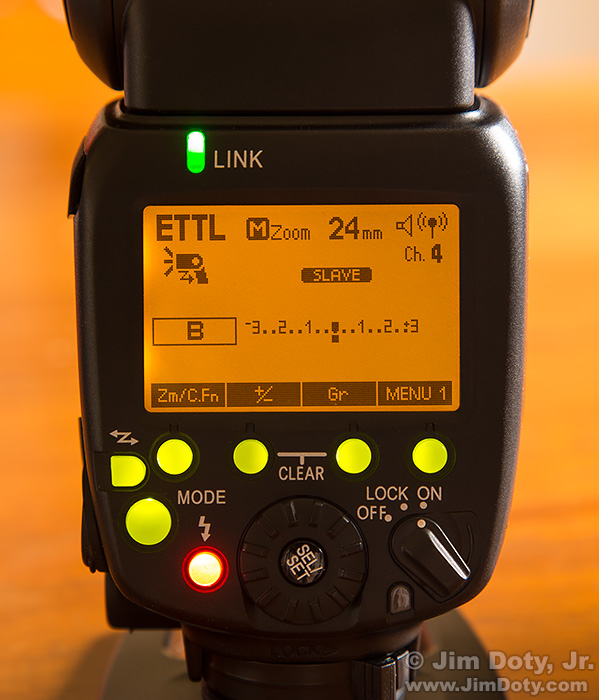Should you spend $499 on a Canon 600EX II-RT speedlite, or $138 on Yongnuo’s nearly identical clone, the YN600EX-RT-II? And what about the radio transmitters? Canon’s is $285 and the Yongnuo copy is $95.00. So you can buy three Yongnuo speedlites plus the radio transmitter for a little more than the price of one Canon speedlite. The price advantage is clear, but what about quality, reliability, and service issues? (Prices as of November 18, 2020.)
Originally posted November 22, 2016. Updated November 18, 2020.
Note: I bought the original Yongnuo model, the YN600EX-RT, when I wrote this article in 2016. Yongnuo now has a model II, the YN600EX-RT-II.
All prices in this article are accurate at Amazon.com (links below) as of the November 18, 2020 update of this article. I use the words “speedlite” and “flash” interchangeably to refer to flash units with hot shoe mounts that can be used both on and off the camera.
As a loyal Canon user I was asking myself the same questions. I use Canon camera bodies and lenses, Canon speedlites, and a Canon radio transmitter. I like Canon quality so to consider an aftermarket product I would need some pretty compelling reasons. The huge price difference was really making me think.
Infrared vs Radio
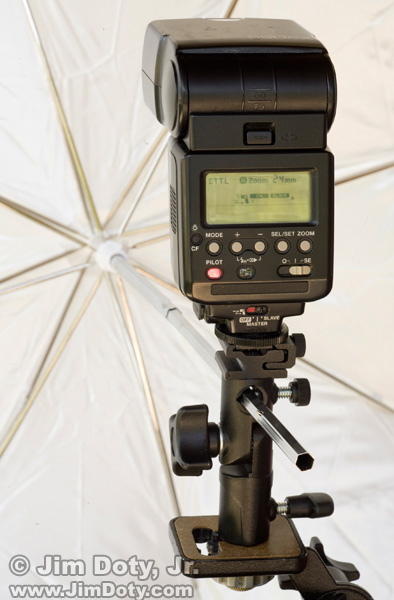
One of my infrared controlled Canon 550 EX speedlites. The “master/slave” switch makes it quick and easy to go off-camera without messing in the menu system.
I loved my infrared system at night or indoors for off-camera flash in close quarters. As long as the distances aren’t too great (more than 25 feet) and I have line of sight communication, it is very reliable.
But I was having all the usual frustrations other photographers have with off-camera, infrared flash systems. Sometimes I want to be more than 25 feet from the off-camera flash. Or the need for line of sight communication is a problem when a flash needs to be behind a wall, or bush, a building, or a person. And then there is the almost total inability for infrared to function reliably during the daytime. Radio communications was the answer but most options are expensive. Buying an aftermarket transmitter for the camera and an add on receiver for each flash, not to mention the flash units themselves, really add up. And the aftermarket systems each have some drawbacks, including some reliability issues of their own.
Enter Canon’s New Radio Flash System
Then Canon developed a game changing system with the radio transmitter and receiver built into each flash. With a minimum of two Canon 600EX II-RT speedlites, one on the camera in transmit mode and one off the camera in receive mode, you have a radio controlled system. Or you can buy the Canon ST-E3-RT transmitter for $299.95 and use one or more Canon speedlites off-camera. Reviews were great and photographers were loving the new found freedom the system gave them. I was sold on the system, but the cost of entry is daunting.
Copycat Systems
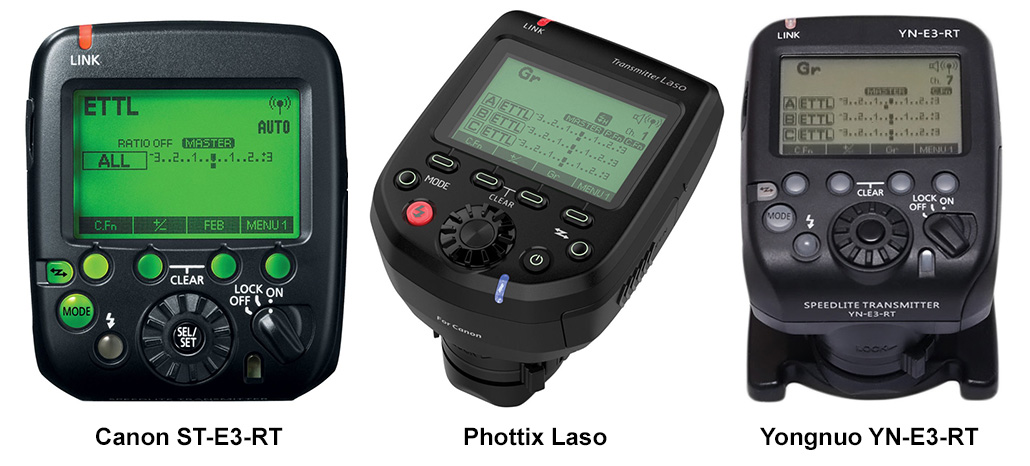
Three Canon compatible radio transmitters with virtually identical control layouts and menu systems. Compare these menu screens to the menu screen closeups below. Click to see a larger version.
Then the copy cat systems started showing up, notably Yongnuo. The Yongnuo system was a virtual clone for the Canon system at a much lower price. The units are not only a very close visual match with the same control layout, the Yongnuo system claims to be totally compatible with the Canon system.
Early Issues with the Yongnuo Radio Controlled System
Unfortunately early reviews were very mixed. Some people had good luck, the system worked very well and was indeed totally compatible and interchangeable with the Canon system. Others had problems with overheating issues, poor communication between units, incompatibility issues, breakdowns of all kinds, and dead-on-arrival speedlites. Quality of control was a serious issue.
Better Reviews and a Decision
I kept reading reviews, especially longer reviews from working pros. Two things happened. The reliability got better over time, and Yongnuo prices dropped even further. Things finally improved to the point that I was ready to roll the dice and try a Yongnuo system. I chose Amazon for their excellent guarantee and generous return period. That gave me some time to test the system and return any defective units. I ordered two speedlites and one transmitter to give me some flexibility with the lighting.
Testing the Yongnuo Gear
When my Yongnuo system arrived I put it through its paces. With a transmitter on the camera and two speedlites set up, one on each side of my dog, I played. Everything worked flawlessly. I had total ETTL control (Canon’s name for through-the-lens automatic flash metering), plus total manual control, all from my camera mounted speedlite or transmitter. I could dial up or down either off-camera flash to increase or decrease the exposure on either side of my dog. Of course I could do all of this with my infrared system too.
Then I did things my infrared system can’t do. I hid one speedlite from the camera/transmitter so they weren’t “line of sight” with each other. The speedlite fired anyway. I used it outside in the daytime. Still worked. I moved the camera and transmitter long distance from the speedlite in the daytime and everything still worked. Totally pleased, I ordered another speedlite to give me a three light system. The total cost of three speedlites and one transmitter from Yongnuo is less than one speedlite from Canon.
I followed up with a real world test with a professional model from California. On a bright sunny day (not the weather we would have preferred), I used two speedlites, one on the camera in transmit mode, and one inside a Halo softbox in receive mode. Everything worked flawlessly. My infrared system could not handle this situation. I am sold!
Using the Yongnuo Menu System
To get started using off-camera, radio controlled flash with the Yongnuo system, you will need a minimum of two speedlites ($230 total) or one speedlite plus one transmitter ($206 total). (You can get just one speedlite to start out and use it like any other flash, but you won’t be able to use it off-camera.)
If you already have a Canon radio controlled flash, you can get additional items made by Yongnuo. The systems are totally compatible with each other.
With two speedlites, you use one on the camera in transmit mode (Youngnuo and Canon both call this the “master” mode) to control the off camera flash in “slave” mode. Or you can have a transmitter on the camera and an off-camera speedlite. And of course you can get more than the minimum, two item system.
With one speedlite on the camera and more than one off camera flash, you can set the same flash exposure compensation for all of the speedlites (left panel above). Or you can set each speedlite to one of 5 groups, A through E, and set the flash exposure compensation separately for each group (right panel above). If you go speedlite crazy and buy a lot of speedlites (some people do that), you can have more than one speedlite in a group, so each individual “group” can have one or more speedlites. I have three Yongnuo speedlites so each is set to a different group (A, B, and C) so I can control each speedlite separately when I want to. You can also use the on-camera flash (or transmitter) to set one or more off-camera flashes/groups to manual mode and set the manual power of each flash/group separately. This means you can combine ETTL groups and manual groups with total control over each group from the on-camera speedlite or transmitter.
Each off-camera speedlite must be set to receive mode which both Yongnuo and Canon call the “slave” mode. Each speedlite comes factory set to group A but you can change the group designation on the back of the speedlite. You don’t need to change the settings on that flash again unless you want to change the group setting or put it on the camera. The on-camera speedlite or transmitter controls all off camera speedlite functions by radio control in both ETTL and manual mode.
The menu system of the transmitter is identical to the menu system of the speedlite when it is in “master” mode. The top transmitter (photo above) has all speedlites in all groups set to the same flash exposure compensation. The bottom transmitter (photo above) has each group set to a different flash exposure compensation. One or more groups could also be set to manual flash output with the amount of manual power for each group set individually using the transmitter.
Yongnuo and Canon Interchangeability
I did not buy a Canon 600 EX-RT speedlite or ST-E3-RT transmitter system so I haven’t tested them together. Those who have (and didn’t get a defective Yongnuo unit) have found the systems totally compatible and interchangeable. You can mix any combination of Canon and Yongnuo flashes and transmitters and they all work together seamlessly.
Optical Mode with Canon and Nikon
You can set the Yongnuo speedlite to “optical” rather than radio mode so it will work with the Canon 580 EX II and 430 EX II speedlites. When set to “iTTL” mode, the Yongnuo YN600EX II-RT will work with Nikon SB900 and 800 series speedlites, providing an inexpensive alternative to Nikon flashes.
Construction Quality
Canon speedlites are very well made. The Yongnuo units don’t feel ultra-cheap, but they are not as well made as the Canon flashes.
The Warning!
There is one more really important thing you need to know.
After the seller’s return period has expired (it is different for each camera store), if a Yongnuo speedlite or transmitter goes belly up, warranty repairs are done only in China and you pay the shipping both ways. Shipping to China is so expensive that it is almost cheaper to just buy another new unit. So for all practical purposes, unless Yongnuo sets up a repair shop in the U.S. (for U.S. shoppers), you essentially have no warranty. With a price that is less than 1/4 the price of a Canon flash, some people say the gamble is worth it, hoping most units that are going to develop problems will do so within the return period.
The Bottom Line
I hope all of this information will be helpful. Now, what should you do? It is your choice. If money is truly no object, you might as well avoid any risk and buy Canon.
If money is an issue (and it is for most of us), and you are willing to take some minimal risks (like a unit quitting after the return period ends), buy Yongnuo. Incidentally, Amazon’s return period is longer than the return period for many camera stores.
Some photographers buy a Canon system and then get Yongnuo gear as an inexpensive backup. If you decide to try Yongnuo, it is prudent to use your Yongnuo gear as soon as you get it from the seller to make sure everything is working properly. Put it through at least two or three shoots before the seller’s return period ends. .
Amazon purchase links for both the Canon and Yongnuo radio controlled flash systems are below.
Photo Shoot
After doing a more serious portrait with his brother and cousins, one of my grandsons was hamming it up in front of the Christmas tree with one silly pose right after another. I used three Yongnuo 600 EX-RT speedlites. One was on the camera. The other two were at camera left and right and pointed up at a white ceiling for nice even bounce light. If I recall correctly, I dialed down the flash exposure compensation to about minus 1 for the on-camera speedlite. The flash exposure compensation on the other two speedlites was around zero (no exposure compensation). The ceiling was high so I used an ISO of 800 for a faster recycle time to keep up with my grandsons rapid fire poses. I wanted the golden glow of the Christmas tree lights (the white balance on my camera was set to flash) so the shutter speed was 1/10 second.
Portrait Photo Data: Canon 5D Mark III. Canon EF 24-105mm f4 lens at 55mm. 1/10 second, f/8, ISO 800. Three Yongnuo YN600-EX-RT radio controlled speedlites in ETTL mode.
Article Links: Off-Camera Flash Series
Some of the Best Off-Camera Flash Equipment
Radio Controlled Speedlites: Yongnuo YN600EX-RT vs Canon 600EX-RT
Light Modifiers (Softeners) for Speedlites
Putting Together a “Studio in a Backpack”
How To Set Up a Halo Softbox or Umbrella with an Off Camera Speedlite
Photo Shoot: Using a Halo Softbox with a Yongnuo Radio Controlled Flash System
Environmental Portraits and Off-Camera Flash, Part 1
Environmental Portraits and Off-Camera Flash, Part 2
Environmental Portraits and Off-Camera Flash, Part 3
AlienBees: High Quality, Economical Studio Lights
Purchase Links
You can order the Yongnuo flash equipment from Amazon.com at the flash for Canon section of my photography store. You can order the Canon radio flash equipment here.
Information Links
To learn more about flash, TTL (through-the-lens) flash metering, manual flash, off-camera flash, studio flash, portrait photography and a whole lot more, read Digital Photography Exposure for Dummies. If is one of the highest rated photography books at Amazon.com. Learn more here and purchase it here.
Ric Latham Photography’s review: Yongnuo YN600EX-RT vs Canon 600EX-RT
Series Link
This is one in a series of articles that will guide you to the best of all things photographic. The rest are here: Buyer’s Guide: Recommendations For The Best Photography Equipment, Software, Books, Magazines, DVDs, Online Photo Labs and More.

